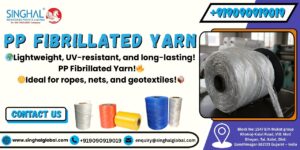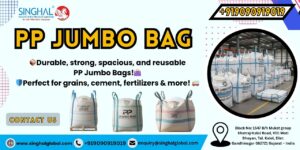Where bulk packaging and shipping of vast amounts of products are concerned, efficiency, safety, and cost-effectiveness are of the utmost importance. Of the numerous packaging options that exist in the present day, Flexible Intermediate Bulk Containers (FIBCs) or jumbo bags are an especially popular choice because they are versatile, long-lasting, and can support a great diversity of bulk materials. Here, we look at how to make the secure use of FIBC jumbo sling bags for bulk packaging.
What are FIBC Jumbo Sling Bags?
FIBC Bulk bags are strong, large bags and are typically constructed of woven polypropylene fabric. They are utilized in handling bulk materials of weights 500 kg up to 2,000 kg or more depending on the application of the client. They feature one or multiple lifting sling loops to hoist, handle, and move the bags conveniently through crane or forklift.
Its production involves a number of layers of material that offer strength, stability, and puncture and tear resistance, which is important when holding bulk materials like sand, grains, chemicals, and minerals. FIBCs may be tailored to meet specific needs, for example, anti-static to use in the transportation of flammable commodities or food-grade to ensure safe carriage of edible products. Singhal Industries is a leading FIBC bags manufacturers in the country.
Essential Features Supporting Secure Bulk Packing
FIBC jumbo sling bags consist of high-quality polypropylene material, which is extremely tensile in nature. The fabric is constructed in a manner that it can withstand heavy weights and rough handling characteristic of bulk carrying. Due to its strength, the fabric gives confidence that bags will be filled to capacity without any risk of tearing, bursting, or deforming during transportation.
For extra security, FIBCs may be reinforced with extra layers or engineered with specific structural elements such as baffles or corner seams that offer additional stability, keeping the bag in shape and integrity even when subject to pressure.
Secure Closure Systems
To provide safety from unintended spillage or leakage in transit, closure of FIBC jumbo bags is very critical. The bags are typically equipped with trustable top and bottom closures such as duffle tops, spout, or flat tops. Duffle tops have a drawstring or flap to close the bag opening securely, while spout tops have easier filling and controlled discharge.
The sealing guarantees that the contents are safe, avoiding loss or contamination while handling and transporting them. Properly closed and sealed, such bags ensure the least risks of product spilling, contamination, and exposure to environmental conditions.
UV Resistance
Most jumbo sling FIBCs are UV stabilizer-treated, protecting the bags against the damaging effect of ultraviolet light This is especially useful for bulk products that have to be warehoused outside or in an open environment. Degradation-resistant UV FIBCs have the strength and usability of the bag retained throughout the transportation and storage process.
The addition of UV protection also increases the shelf life of the bag, minimizing the chances of tears or damage caused by exposure to sunlight, and thus ensuring ongoing protection of the material.
Weight Tolerance and Load Distribution
Even weight distribution inside the bag is crucial in an attempt to avoid instability. Jumbo sling bags in FIBC contain over one loop for lifting to offer equal weight distribution. This means weight distribution in the bag and not applying too much pressure to a single point of the bag, thus less likely to cause damage during lifting or moving it.
The slings, which are adjustable in a number of ways, are placed at the sides or corners in a calculated manner to provide an even load, even when the bags have heavy or uneven contents. This gives confidence that the bag is secure and stable, even in extreme conditions.
Best Practices for Ensuring Safe Bulk Packaging
To ensure safe bulk packaging using FIBC jumbo sling bags, best practices are necessary right from the beginning of the process, beginning with selection, right up to loading and transportation.
Select the Correct Type of FIBC
The correct type of FIBC to be used for the product being shipped has to be chosen. The material’s weight, fragility, moisture sensitivity, and potential to create static electricity should be considered in choosing the appropriate bag. Improper selection will lead to damage to the product, contamination, or even accidents.
Proper Filling and Handling
To keep the FIBC bags stable while in transit, proper filling has to be done. Bags cannot be filled completely full or incompletely full, as this could lead to instability or structural failure. The weight of the contents has to be properly distributed so that it would not shift upon movement.
Besides, while lifting and handling FIBCs, it should be done with care to ensure that the lifting loops are utilized correctly and no sharp tips or heavy equipment come into contact with the bags, which may cause damage.
Routine Inspection and Maintenance
FIBCs shall be inspected for wear or damage on a regular basis, paying special attention to lifting loops and seams. Frayed, worn, or loose-stitched bags should be repaired or replaced as soon as possible to provide for safe use over the long term.
Safety Standards Compliance
Lastly, following industry-orientated safety policies and regulations will allow for the safe utilization of FIBC bulk bags. Following ISO standards for FIBCs (such as ISO 21898) and other local regulatory codes can guarantee that the bags function as desired under diverse situations.
Conclusion
FIBC jumbo sling bags are a critical solution to secure bulk packaging of products. Because they are strong, durable, and can be made to order, these bags are a safe and efficient way of moving bulk products, reducing the risk of spills, contamination, and structural failure. By choosing the proper type of bag, adhering to best practices for loading and handling, and regular inspection, companies can be confident that their bulk packaging is safe along the supply chain, from storage to final delivery.
Frequently Asked Questions (FAQs)
How much weight can an FIBC Jumbo Sling Bag carry?
Sling Bags have an excellent Safe Working Load (SWL) of 500 kg to 2,000 kg so you can work from light weight to heavy weight.
What materials are FIBC Jumbo Sling Bags made from?
There are different materials that can be used by manufacturers to produce bulk bags. The most common material used to produce FIBC bags, however, is polypropylene — a petroleum derivative.
How do FIBC Jumbo Sling Bags improve logistics efficiency?
FIBC bulk bags minimize the transportation cost since they reduce the packaging weight without decreasing the volume of the material being transported.
Are FIBC Jumbo Sling Bags suitable for outdoor storage?
Jumbo bulk bags are very resilient in withstanding adverse climatic conditions.









